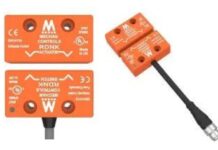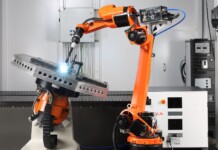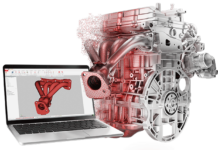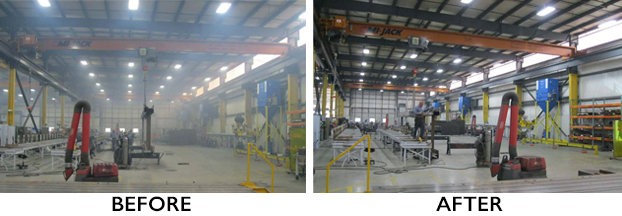PROBLEM
Excessive weld fume in weld shops: P&H Mining builds some of the world’s largest mining shovels and equipment in the large (600’ x 125’ x 60’ and 300’ x 85’ x 60’) Milwaukee plant. They became concerned that the very heavy dust load produced by welding, back gouging and grinding was not being controlled in a way that was consistent with their fine reputation as building the best equipment in a state-of-the-art facility. Even though the metal dust concentrations were not exceeding any regulatory limits, the managers at P&H knew that a visible haze in the building might be perceived negatively.
ALTERNATIVES
P&H carefully weighed the pros and cons of the conventional industrial ventilation techniques such as: source capture hoods, large building exhaust fans, a central ducted filtration system and a network of self-cleaning filtration units.
SOLUTION
Some type of general ventilation/filtration system was the only practical alternative design in this large fabrication facility because overhead cranes and large weldments precluded the use of fixed hoods or smaller portable collectors to capture most of the dust. (Source capture devices had already been in place where they were unobstructed.) This system requires that the entire volume of the building must be considered in determining the total flow capacity of the air filtration units. Overall flow rates must be much greater than those used for direct capture. This is because effective air flow patterns must be established to induce the fume upward into the system. It was necessary to incorporate the air cleaning system design with the general heating and ventilating system, thus combining fans and air distribution systems and to keep the air makeup and heating units clean.
A comprehensive analysis was applied to determine the total recirculation air flow. The major factors were based on specific hard data for the facility such as the average daily weld wire consumed, the weld process itself and the existing exhaust air /makeup air. Thus the fume is removed utilizing 1. Industrial air cleaners, 2. Exhaust with clean make up air, and 3. Some local source capture hoods.
The focus at this point was to reduce the concentration of fume in the general plant air. The basic goal was to remove all visual airborne contaminants and to cut the existing contaminants by a substantial percentage and thus go well beyond the air quality safety standards toward a clean environment for all employees and customers. This level was measured and controlled by pre and post testing of background contaminant.
The P&H team decided to install (63) Filter 1 Flowtron Air Cleaners — fan-powered, self-cleaning filtration units that are all connected to a central vacuum collector for fully automated dust purging and removal. The filters are backflushed for a few seconds per day based on actual real time filter dust loading. The status of each collector from the motor speed to the cleaning frequency can be easily monitored from any internet connection. This cleaning process is completely unique in the industry.
Intelligent controls, including variable frequency drives (VFDs) control speed and energy consumption based on maintaining a constant air flow. In conjunction with the air cleaning system P&H incorporated the existing air makeup and ventilation systems into the total solution that is monitored and controlled through our integrated Building Automation System (BAS). The system installation, which incorporates the existing air makeup system, is designed to produce a three dimensional air pattern to control the welding fume from the floor to the sixty foot ceiling. In this way the otherwise stagnant and potentially hazy spots in the plant are eliminated. This challenge is accomplished in spite of the fact that heavy welding and some back gouging occurs at many elevations all over the plant from the floor to as high as thirty feet above the floor.
Hastings Air Energy Control, Inc. analyzed the problem, designed a comprehensive and integrated system, managed the installation, commissioned the on-time start up, and has been monitoring the performance on-line through the intelligent control system.
RESULT
Ted Leamen, Director of Global Environmental Health and Safety for P&H, had this to say, “Our adjoining large weld facilities totaling 126,000 square feet and 60 feet high had particulate levels that were under the OSHA limits, however, we wanted to provide better protection for our workers. In our effort to continue to become a world class organization we needed a robust system to remove the heavy weld fume from our operations in the large weld facility. We also needed a system that was flexible to modify as our process changes, would accommodate our growth, easy to maintain and easy to control as the climate changes in Wisconsin.
“We can see the results while you easily look across the bay in the facility. Independent testing yielded a 70%+ reduction in particulate matter. We are very proud to walk any of our customers and prospective customers through the Large Weld facility at any time of the day or night. Our employees are providing positive feedback and our attendance metrics have improved since the system has been implemented. We have plans to model this approach into our Global Transformation Initiative. We also received a grant from Focus on Energy for more than $350,000.00 to help us make this decision at this time. We are thankful to Hastings Air Energy Control for listening to our employees and for providing a solution that works!”



















